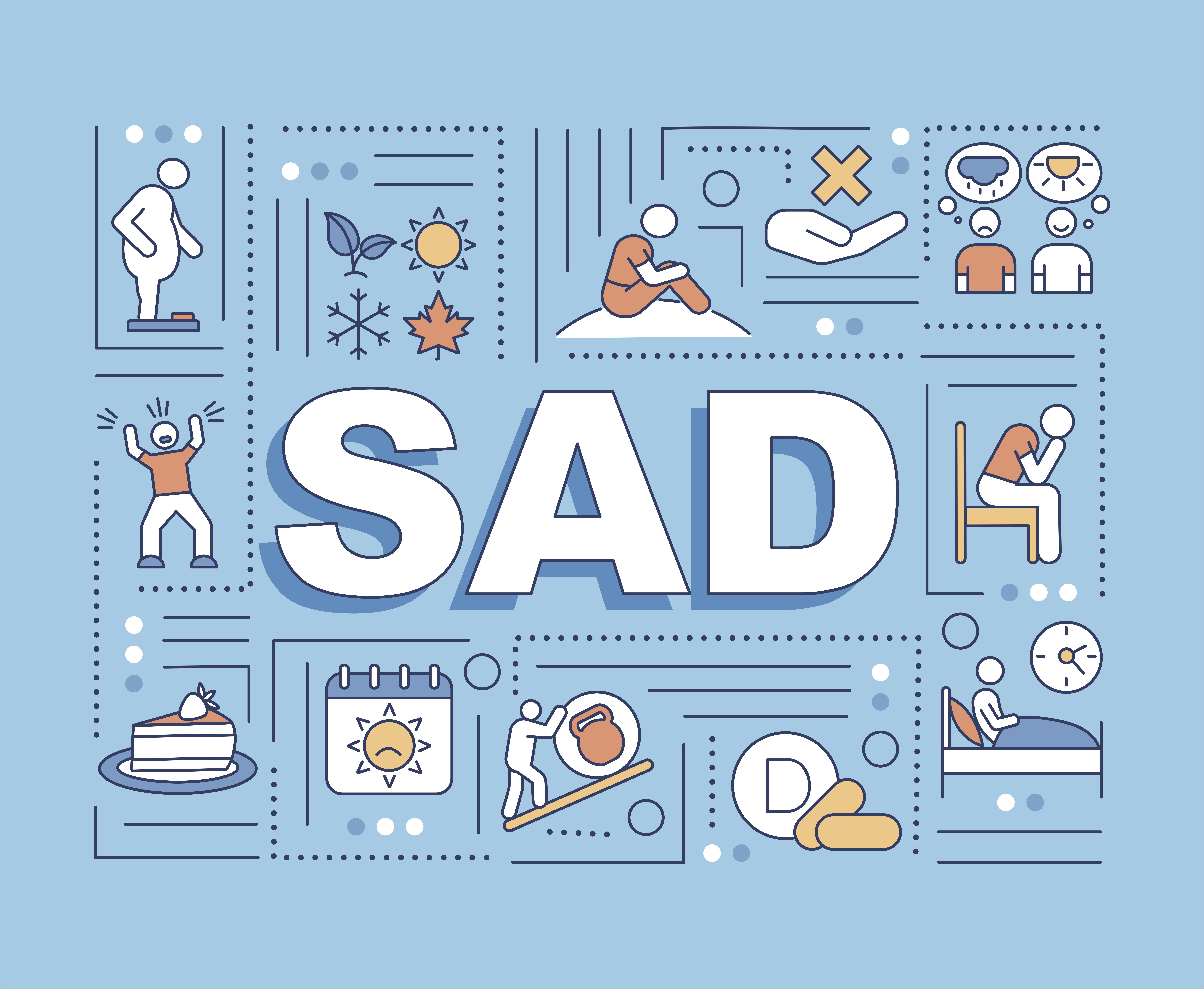If the winter months have you feeling down, or if symptoms of depression are interfering in your life, try these tips to help keep seasonal depression at bay.
The late fall and winter months mean cozy fires, hot cups of cocoa, and holidays, but it can also come with a change in mood. Often called the winter blues, feelings of tiredness, sadness, and reduced motivation can occur when colder months roll around. But winter doesn’t have to be the saddest season; here are some science-backed tips to help you handle seasonal depression.
“What good is the warmth of summer, without the cold of winter to give it sweetness?”
— John Steinbeck
What is seasonal affective disorder?
Seasonal affective disorder, or SAD, is a type of depression. It’s brought on by the shorter days of winter because of less daylight. Light exposure plays an important role in regulating our sleep patterns, hormones, and mental health. Because we get less sunlight during the colder months, we can feel down.
Here are some of the ways seasonal affective disorder comes about:
- Your biological clock (circadian rhythm): The reduced amount of time in sunlight may disrupt your body’s internal clock, which can lead to feelings of depression.
- Serotonin levels: Reduced sunlight can cause a drop in the neurotransmitter serotonin, and a reduction in serotonin affects mood and may trigger depression, making you vulnerable to SAD.
- Melatonin levels: The balance of your body’s level of melatonin, which plays a role in sleep patterns and mood, may be off.
What are the symptoms of SAD?
People impacted by seasonal affective disorder experience significant mood changes. They can manifest as feelings of sadness, hopelessness, tiredness, and lack of motivation. People dealing with all types of depression, including SAD, often find that they have trouble eating and sleeping, feel socially isolated, feel anxious, question the point of life, and struggle to function at their normal level.
If you have these symptoms and they remain for more than a few days, and if you find them interfering in your day-to-today life, it may be true for you that less sunlight is leading to an episode of seasonal depression.
Are you feeling low, or are you experiencing symptoms of depression?
We all feel sad and low at times. These feelings are part of the wide range of human emotions we all experience. The dark, cold days of winter means that we may experience these feelings more acutely—the winter blues are common, after all.
But it’s important to realize when a general low mood has transitioned into symptoms of seasonal affective disorder or depression. Please do not dismiss signs of depression in yourself or others, because it is not something to take lightly, especially with rates of suicide on the rise.
Here are signs that you or someone you know might need professional help:
- Feeling sad or down most of the day, nearly every day
- Losing interest in things you previously enjoyed
- Having less overall energy
- Sleeping and/or eating more than usual
- Difficulty concentrating
- Feelings of guilt, worthlessness, hopelessness
- Having thoughts about not wanting to stay alive
When sadness starts to interfere with your ability to function and complete everyday tasks, please reach out to a trusted friend or family member, or seek help from a healthcare provider.
How to deal with seasonal affective disorder
Although it can be difficult to face seasonal affective disorder when the symptoms of depression are giving you less energy to confront challenges, keep in mind that SAD is almost always temporary. Plus, there are lifestyle strategies, antidepressant medications, and treatments that can help. Here’s a list of what you can try today:
1. A regular sleep schedule
Our moods and mental health are not just impacted by how much sunlight we receive but also by how much sleep we get. Healthy sleep patterns encourage healthy hormone production, metabolic functioning, emotion regulation, and more—and it can leave you in a better mood.
To ensure that your sleep routine is good enough, make sure that you:
- Go to sleep and wake up at a similar time every day.
- Reduce blue light exposure for at least one hour before bedtime. This means putting away your phone and computer.
- Set a routine to help signal to your mind that you’re ready for sleep. This could be as simple as having a hot shower or drinking a cup of chamomile tea before bedtime.
- Open the curtains and expose yourself to natural light after you wake up. If it’s not too cold, consider stepping outside into the natural light for a few minutes.
2. Boost your vitamin D levels
Vitamin D plays an important role in mental health, with studies finding that low vitamin D levels are associated with a higher risk of depression. Normally, we get most of our required daily vitamin D through sunlight, but during the shorter days of winter, this can be a little tricky.
The good news is that there are lots of foods high in vitamin D that you can eat to increase your levels.
Foods high in vitamin D include:
- Oily fish, such as salmon and sardines
- Red meat
- Egg yolk
- Mushrooms
- Vitamin D–fortified milk, orange juice, and cereals
3. Light therapy
For people who live in areas with a lot of winter sunlight, like California, finding enough sunlight to keep vitamin D levels up may not be an issue when you put your mind to it. By getting outside during daylight hours and spending some time soaking in the rays, you’ll be helping to fight off the winter blues.
For anyone living in areas with dark, cold winter months and less potential for natural exposure to sunshine during daytime hours, you might be a good candidate for light therapy. Light therapy uses a lightbox to provide simulated sunlight. Sitting in front of this light for the recommended amount of time can help boost your vitamin D levels and improve your mood.
4. Seek joy
“I love the scents of winter! For me, it’s all about the feeling you get when you smell pumpkin spice, cinnamon, nutmeg, gingerbread and spruce.”
— Taylor Swift
Winter often means staying inside and not having access to some of the activities that we love. Making more effort during winter for events, people, and activities that make you happy can help break up the humdrum of winter—and it may put you at less risk for SAD. Just because it’s cold outside doesn’t mean you can’t have fun or dive into something inspiring.
Try these activities:
- Catch up with friends. Belonging is a strong motivator.
- Make the most of winter activities. Try skiing, ice skating, taking brush walks, or enjoying steaming cups of cocoa.
- Exercise. Physical activity can help reduce stress and break up your day. If the weather makes it impossible to go outside, try attending an online exercise class.
- Meditate. We have plenty of evidence that meditation is good for mental and physical health. The quiet of winter months can make it an ideal time to build this habit.
- Start a spiritual practice. Winter can be a perfect time to plant seeds of learning and exploration, to engage in deepening the activities that relate to your connection to meaning or to something bigger than yourself.
- Make plans. When you can look forward to good times ahead, it can bring about a sense of hope. Be sure to put them on the calendar.
5. Meet with a healthcare provider
Last but not least, don’t wait to get help if you are struggling. You may be a good candidate for antidepressant medicines if your symptoms of SAD are interfering with your functioning. Knowing the type of depression you are dealing with and the causes will inform the best treatment options.
While medication, supplements, or light therapy may be advised, an intense or mild version of SAD may change dosage recommendations and the amount of time you spend in front of the bright light. Healthcare providers have access to the latest clinical research about what works.
Yes, seasonal affective disorder is real
Whatever you do, don’t question the validity of SAD. Seasonal affective disorder can show up for some people in the fall and winter months, or it can manifest during spring or summer. One thing is certain: Sad is real, and symptoms can undermine your quality of life. If you are struggling to get through the days at any time of the year, please ask for help from someone you love or from a healthcare provider. You are worth it.
“In the depth of winter, I finally learned that there was in me an invincible summer.”
— Albert Camus
Citations:
Anglin, R., Samaan, Z., Walter, S., & McDonald, S. (2013). Vitamin D deficiency and depression in adults: Systematic review and meta-analysis. British Journal of Psychiatry, 202(2), 100-107. https://doi.org/10.1192/bjp.bp.111.106666
Mayo Clinic. (2021). Seasonal affective disorder (SAD). December 14. https://www.mayoclinic.org/diseases-conditions/seasonal-affective-disorder/symptoms-causes/syc-20364651
Sansone, R. A., & Sansone, L. A. (2013). Sunshine, serotonin, and skin: A partial explanation for seasonal patterns in psychopathology? Innovations in Clinical Neuroscience, 10(7-8), 20–24.
Yoo, S. S., Gujar, N., Hu, P., Jolesz, F. A., & Walker, M. P. (2007). The human emotional brain without sleep: A prefrontal amygdala disconnect. Current biology: CB, 17(20), R877–R878. https://doi.org/10.1016/j.cub.2007.08.007
All Blogs


